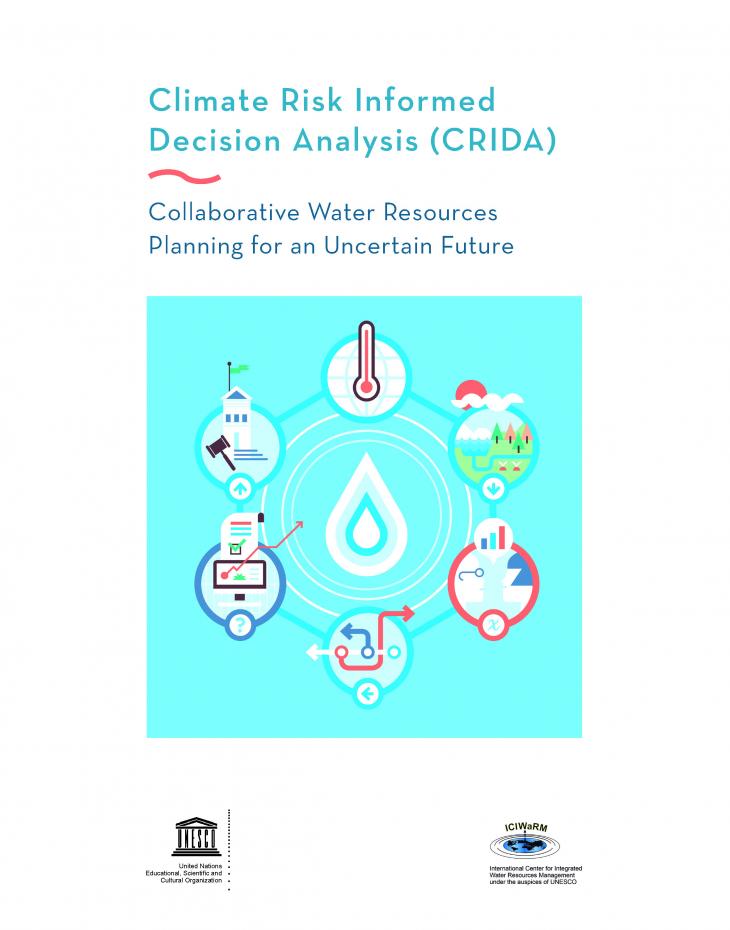It’s not every day that the United Nations takes notice of your research, but that’s exactly what’s happened for one research team supported by the National Socio-Environmental Synthesis Center (SESYNC).
Since its publication by the United Nations Educational Scientific and Cultural Organization (UNESCO), the Climate Risk Informed Decision Analysis (CRIDA) methodology has come to embody “actionable science”—with its adoption and implementation by decision makers around the world.
The CRIDA methodology is a framework developed for water resource managers and policy makers to integrate the uncertain effects of climate change into water resource management and adaptation. It emerged from the SESYNC project EcoEngineering Resilience, led by Drs. LeRoy Poff and John Matthews, with co-development from the U.S. Army Corps of Engineers.
“The heart of what we were trying to address is a really long-standing gap, specific to how we make decisions around water management,” said Matthews, Executive Director of Alliance for Global Water Adaptation. He explained how traditionally engineers and economists have had the greatest involvement in decision making about water resources, without much input from ecologists. Their SESYNC project aimed to change that.
The group focused on “eco-engineering decision scaling,” (EEDS), an approach that includes stakeholders in identifying ecological and hydrological vulnerabilities to climate change, as well as analyzing risks associated with water-infrastructure failures. By bridging ecological and engineering perspectives, EEDS aims to help decision makers balance economic development with hydro-ecological stewardship when designing, building, and operating water infrastructure.
Matthews said CRIDA, which builds upon EEDS, was born about a year prior to their project but took off slowly until their interdisciplinary project. “We were really able to supercharge CRIDA, almost kind of using the conceptual engine from SESYNC as the main driver for it and to build that out as an explicit guidance for engineering-oriented, public-sector water managers that were often working in places with very limited data or maybe very limited capacity and support,” Matthews explained.
The resulting document was a five-step process to help decision makers consider different futures based on uncertain climate change impacts so they can identify adaptable and flexible strategies for water conservation and management.
Another key component of CRIDA is that it takes a bottom-up approach—involving the participation of local communities in the analysis from the start. This approach helps planners consider the water vulnerabilities of indigenous populations, as well as incorporate a gender perspective, to develop adaptive solutions that meet the needs of the local users.
UNESCO’s International Hydrological Programme took notice of CRIDA and eventually published it in 2018. Since then, UNESCO offered in-person training workshops and later offered an online training and certification program in CRIDA that has since had 1700+ participants. It has also translated CRIDA into Spanish, French, and Arabic, with plans for translations in Portuguese, Mandarin, and Russia to be published later this year. UNESCO even included CRIDA into its most recent 8-year plan with hopes to roll out CRIDA to UNESCO’s 190+ member countries.
Additionally, both the World Bank and the Green Climate Fund have given CRIDA their highest climate-resilience methodology rating.
Over the past few years, CRIDA has been adopted in countries like Vietnam, Zambia, and South Africa, as well as in the United States by state agencies in California.
“The main pilot that they developed in California is really exciting, and I think it’s a beautiful example of the power of CRIDA and really this combined eco-engineering thinking more generally,” Matthews said. “It’s going to scale very rapidly in California. But, even more generally, they’re trying to drop the whole decision-making framework of CRIDA down to quite local levels, like sub-county, city levels in water decision making. The goal for that is by 2027 it will be at quite local levels in California.”
Building upon its interdisciplinary foundation at SESYNC, CRIDA has the potential to create even more sustainable water solutions, by elevating the importance of integrating ecological, economic, and engineering principles in water management decisions.
“Our hope was to actually move some of those ideas, just like on our [SESYNC] pursuit, to say if we think about long-term economic viability, we have to think about eco-hydrological systems. We can’t separate out water as a molecule from water as kind of a larger medium for how we carry our whole economies and ecosystems into the future.”
Learn more about CRIDA and the SESYNC project EcoEngineering Resilience.
